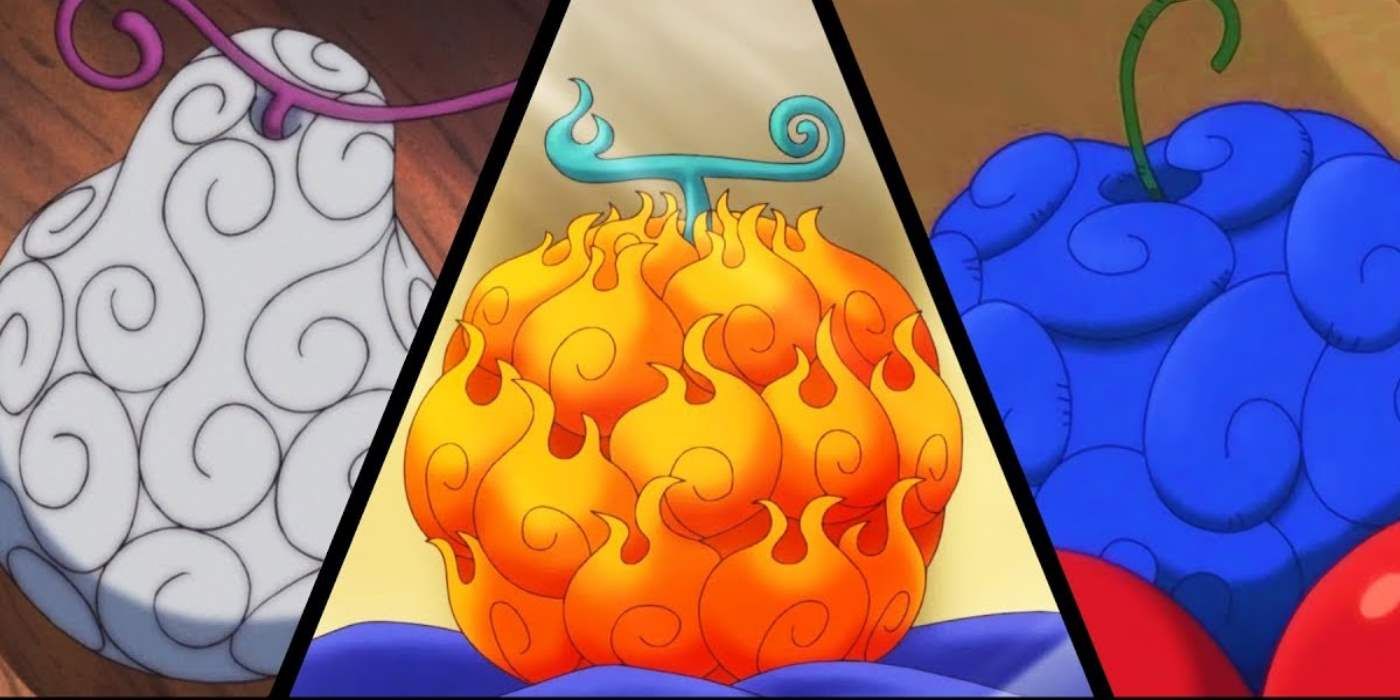One Piece: Devil Fruits explained

So before hockey was the main power system of One Piece, the series mainly relied on devil fruits. And while they were very unorderly, devil fruits and their users were given certain classifications and weaknesses to balance out their powers. That’s what we’re here to talk about today. I’m going to be going over devil fruits and everything surrounding them.
So, to begin with, a brief explanation: devil fruits are mysterious fruits that, upon eating them, give someone some type of power. And this power can range from something as mundane as turning into small spheres, or something as crazy as shattering entire Islands in half with one punch.
The origin of devil fruits is completely unknown. Some people think that they originate from some type of tree, while others think that they’re created by people, which is supported by the fact that fruits like the arms-arms fruit allow people to turn into modern weapons. Devil fruits are recognized by their swirly patterns and their horrendous tastes.
And even if you take a small bite of the fruit, you will automatically gain its powers and the fruit itself will become useless to anybody else. Speaking of which, there can only be one of each devil fruit or their users at any given time. And if the user dies, their devil fruit will reincarnate somewhere.
Now, you might be saying, “Well, oh, all I have to do is eat a shitty fruit and I’ll get powers? Epic!” Well, no, because upon eating any devil fruit, the user will automatically lose their ability to swim and go completely numb upon entering any body of water. Even if that may not sound like much, the One Piece world is made up primarily of water.
So anytime you’re traveling Island to Island, you’re putting your life at risk. Also, to keep devil fruits balanced, you can only have eaten one, or you will die a horrible painful death, with one exception, but we’ll get to that later. You can classify any devil fruit under three different categories: Logia, Zoan, and Paramecia.
Logia fruits are the rarest of the three categories, and that’s for a very good reason. These fruits allow their user to conjure and manipulate a certain type of element. So, think of ice, fire, lightning, and there’s even a devil fruit for light. A user of a Logia devil fruit can even become intangible by just turning into the element that they wield, which will negate any attack they get hit with.
This intangibility is so effective that a Logia user can get shattered into pieces and still remain as if they were never hit. The only way to counter this intangibility is to use attacks with Armament hockey, which most people don’t know how to use. So at times throughout the series, some characters like Smoker or Aokiji can seem basically unbeatable.
On top of all that, some Logia fruits have special side abilities, such as the sand-sand fruit being able to absorb moisture or the dark-dark fruit being able to nullify all other devil fruit abilities. Now, because they are based on elements, some Logia fruit users have hard counters to their powers. A good example of this is when Enel, the holder of the Rumble-Rumble fruit, defeated everybody on Sky Pio with his lightning powers except for Luffy because Luffy is made out of rubber.
However, generally speaking, the Zoan category is the most overpowered out of the three, and I don’t think you can argue that for the other two. Now, Zone devil fruits aren’t necessarily the worst out of the three, but in my opinion, they offer the least amount of value, as being able to turn into an animal is not that big of a deal.
But this category does have some Heavy Hitters for sure. As I said before, zoan fruits allow their user to turn into a specific type of creature, and since there are a wide variety of organisms in the One Piece world, zoans are usually classified by their type. These types include carnivorous zoans, which include animals like leopards or wolves, ancient zoans, which include creatures like dinosaurs or mammoths, and mythical zoans.
Mythical zoans are even rarer than logia fruits, and they allow their users to turn into creatures like giant dragons or Invincible blue phoenixes (I hope that’s the plural of… is it Phoenix or Phoenix? Whatever, it doesn’t matter). There’s even a more precise way to classify Zone fruits, which is by their model. For instance, the dog-dog fruit sounds like it’s one thing, but there’s actually a model for a wolf, a jackal, and a wiener dog.

Now, earlier, I kind of downplayed zoens by just saying that they allowed their user to turn into an animal, but it’s not that simple. Zone users can not only turn into their creatures but also a hybrid form. And beyond that, with some scientific manipulation, Zone users can even get more forms, as seen with Chopper’s Rumble balls.
Paramecia-type devil fruits are the most common among the three. These fruits usually give their user the power to alter their own body, alter the environment, or generate a substance. But since there are some paramecia fruits that don’t fall under these three categories, I like to think of the paramecia category as literally every other power that doesn’t fall under zoan or logia.
For instance, the venom-venom fruit allows its user to conjure, manipulate, and be immune to poisons, but they can’t turn their body into poisons like a logia fruit user can. However, there is one paramecia called the mochi-mochi fruit that can pretty much do everything that a logia can. This fruit was classified as a logia in the original magazine release, but it was changed in the volume release to be a special paramecia for some reason.
Another example of this category’s varying abilities is the Tremor-Tremor fruit, which allows its user to create shock waves and earthquakes by just punching the air. This is also a good example of some paramecias being even more OP than mythical zoans or logias, as the Tremor-Tremor fruit can destroy entire islands with one punch.
But that’s what I think is the most interesting thing about devil fruits as a power system. Unlike chakra, reiatsu, or ki, devil fruits are way less linear, and every fight is different because each combatant has a different power. Sure, some fruits are weaker or stronger than others, but that doesn’t necessarily mean that someone will prevail just because they have a logia and their opponent has a paramecia.
A good example of this is Luffy’s Gum Gum Fruit, which seemed completely useless at first but after training throughout his entire childhood, he honed this power to the point where he can One-Shot sea monsters. Now, keen-eyed viewers may notice that I called Luffy’s fruit the Gum Gum Fruit, and that’s not its actual name.
Luffy’s fruit is actually classified as a Paramecium Owen Fruit, and it’s called the Human Human Fruit Model Nika which, upon Awakening, allows its user to become a Sun God. Now, you may be asking, “what is an Awakening?” Well, shut up, I’m about to tell you. A Devil Fruit Awakening is when the user unlocks the full potential of the fruit after mastering its powers.
A Paramecia Awakening, for example, will allow the user to turn their environment into the substance that they generate or do other crazy things because it really just depends on what powers you have. The Zoan Fruit Awakenings that we’ve seen allow their user to turn into a monster version of their respective creature, and the Logia category, at the time of me recording this, doesn’t have any confirmed awakened users yet, but there are theories.
The most popular of these theories is about Aokiji and Sakazuki, the wielders of the Ice Ice Fruit and the Magma Magma Fruit. During their 10-day battle on Punk Hazard, they permanently turned the island into an Arctic climate and a hellscape, respectively, which may indicate that a Logia user’s awakened ability is the power to permanently alter their environment.

And both of these combatants were Admirals in the Navy, which kinda tells us that they have enough skill to master their powers. Another theory about awakened Logias that I have is Blackbeard, who despite the odds, managed to acquire two Devil Fruit Powers. Blackbeard has the Dark Dark Fruit, which as I stated before, can nullify all other fruit powers, so who knows, maybe this fruit’s Awakening is to just absorb other people’s powers entirely, but that’s just me.
So there is one more category of Devil Fruits that I forgot to mention, and that’s the artificial fruits. These fruits are exactly what they sound like; they are created by humans, and they have circling patterns instead of swirly ones. The first artificial Devil Fruit was created by Dr. Vegapunk, but he considered it a failure, even though it can do literally everything that Kaido’s dragon fruit can do.
Caesar Clown also made his own branch of artificial Devil Fruits called the Smiles, and they allow a person to partially transform into an animal, which is just trash. And not just that, but only one out of 10 people who eat the Smile fruits actually gain its abilities, and the other nine just have permanent Smiles on their face for the rest of their lives.
Finally, I want to mention another weakness of all Devil Fruits, which is called Sea Stone. Sea Stone is a very rare material that can negate all Devil Fruit Powers. So for instance, putting Sea Stone cuffs on a fruit user will negate their powers completely. It doesn’t matter what category they’re in, same thing with a Sea Stone weapon. If you hit a fruit user with it, it will damage them no matter what.
So that’s pretty much everything important about Devil Fruits.
So let me know down in the comments below which power system is your favorite: devil fruits or hockey? Me personally, I think that devil fruits are a very unique power system, if you can even call them that, but they were very unlinear and hockey definitely brought order to things. But that’s it for this blog, and I’ll see y’all next week when I cover Luffy’s gears.
That’s me, Andreea Blaga, author of the blog anime-everything.com. I work as a content creator in the US. I am also passionate about Japanese Anime.


Related post
Why JJBA is the Most Bizarre Anime Ever Made
When discussing iconic anime series, one title that consistently stands out is “JoJo’s Bizarre Adventure,”...
Oct
The Impact of Wind Breaker on the Sports Anime Genre
The sports anime genre has seen numerous iterations over the years, captivating audiences with its...
Sep
Decoding the Enigmas: Exploring the Hidden Secrets of Gravity Falls
“Gravity Falls,” created by Alex Hirsch, is a beloved animated series that has captivated audiences...
Aug
The Rise of Kaiju No. 8: A New Era of Monster Manga
The world of manga has always been rife with innovative storytelling and vivid illustrations, but...
Aug
Character Study: Korra and Aang’s Legacy
In the richly woven tapestry of the “Avatar” universe, the characters of Korra and Aang...
Jul
Islands of Wonder: Exploring the Unique Geography of One Piece
Enter the vibrant world of One Piece, a beloved manga and anime series created by...
Jul